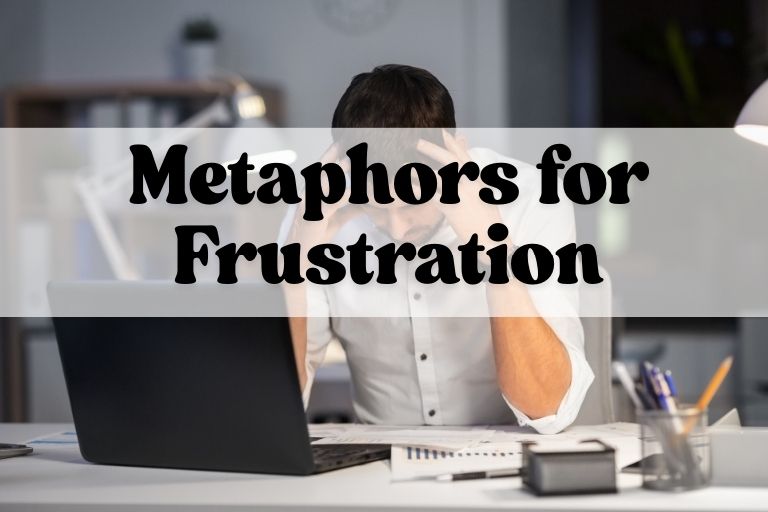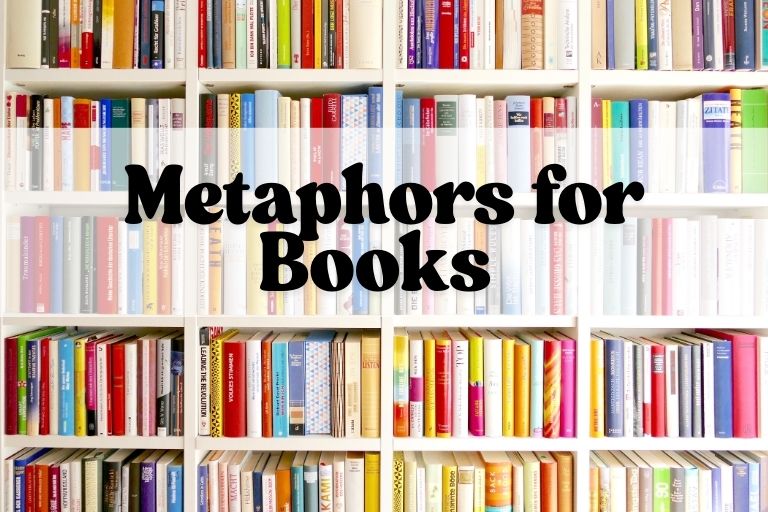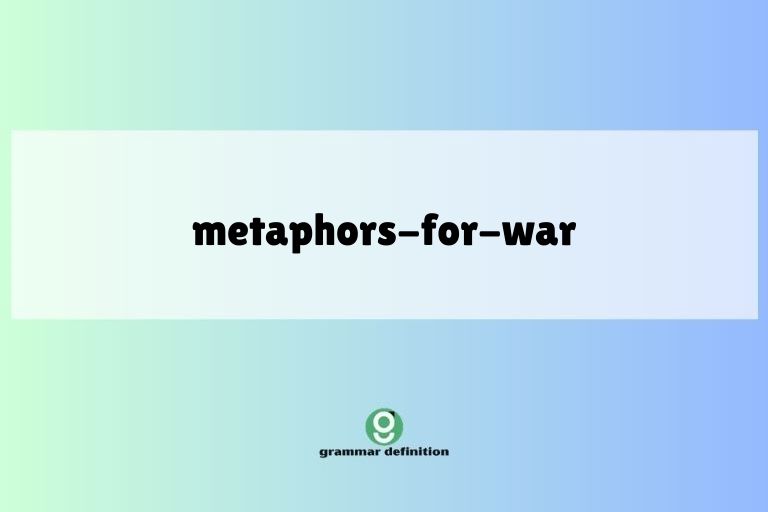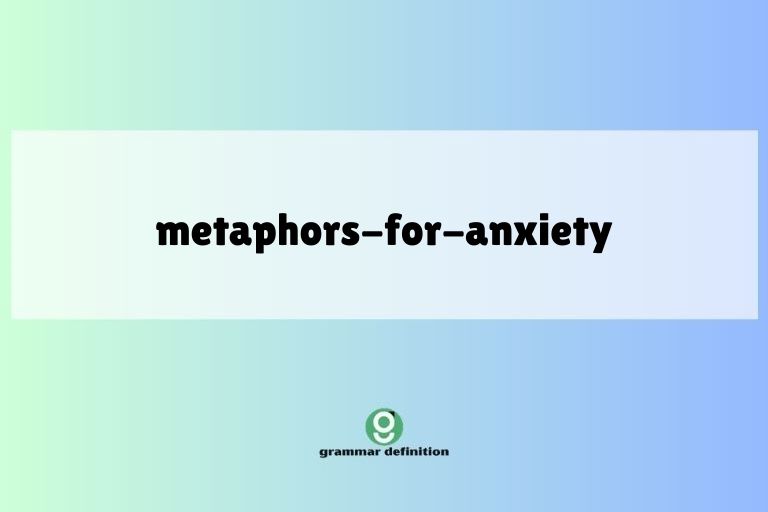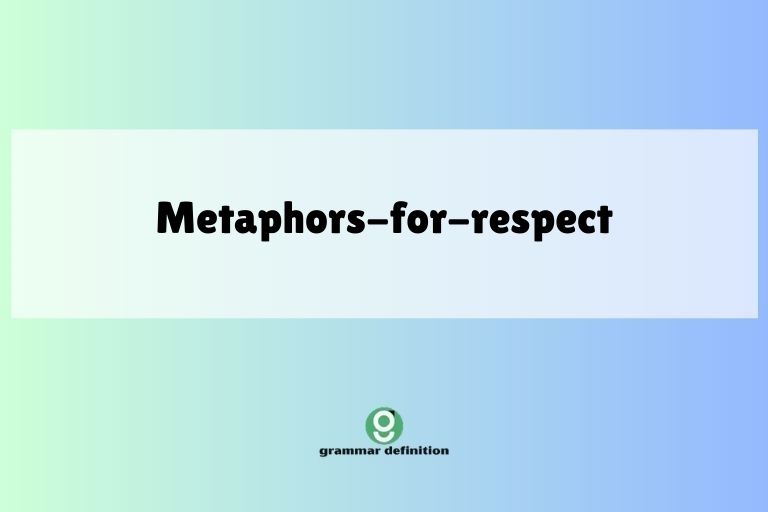Metaphors for Change: A Comprehensive Guide
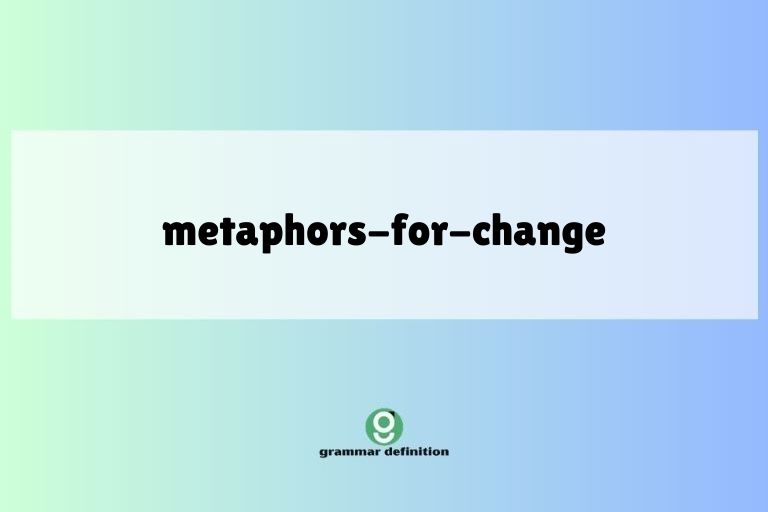
Metaphors are powerful tools in the English language, allowing us to understand abstract concepts by relating them to something more concrete. When it comes to discussing change, metaphors provide a vivid and relatable way to express complex transformations, evolutions, and shifts in perspective.
Mastering the use of metaphors for change not only enhances your writing and speaking skills but also deepens your understanding of how language shapes our perception of the world. This article will guide you through various types of metaphors for change, providing numerous examples, usage rules, and exercises to help you become proficient in their application.
Whether you are a student, a writer, or simply someone looking to improve their communication skills, this guide will equip you with the knowledge and tools to effectively use metaphors to describe and understand change.
Table of Contents
- Introduction
- Definition of Metaphors for Change
- Structural Breakdown of Metaphors for Change
- Types of Metaphors for Change
- Examples of Metaphors for Change
- Usage Rules for Metaphors of Change
- Common Mistakes When Using Metaphors for Change
- Practice Exercises
- Advanced Topics in Metaphors for Change
- Frequently Asked Questions
- Conclusion
Definition of Metaphors for Change
A metaphor is a figure of speech that directly compares two unrelated things, suggesting a similarity between them. Unlike similes, which use “like” or “as” to make a comparison, metaphors state that one thing is another. Metaphors for change are specifically used to describe processes, events, or states that involve alteration, transition, or evolution. They help us understand abstract or complex changes by framing them in terms of something more tangible and relatable. The function of these metaphors is to provide a new perspective, evoke emotions, and simplify understanding.
Metaphors for change can be found in various contexts, including literature, business, personal development, and everyday conversation. They are used to describe everything from personal growth to organizational restructuring to societal shifts.
By using metaphors, we can make change feel less daunting and more understandable, as well as highlight specific aspects of the transformation we want to emphasize.
Structural Breakdown of Metaphors for Change
Metaphors for change typically consist of two main elements: the tenor and the vehicle. The tenor is the subject being described (the change itself), and the vehicle is the thing to which the tenor is being compared. Effective metaphors create a strong connection between the tenor and the vehicle, highlighting shared characteristics or processes.
For example, in the metaphor “Life is a rollercoaster,” “life” is the tenor (the thing undergoing change), and “rollercoaster” is the vehicle (the thing it’s being compared to). The shared characteristics are the ups and downs, the unexpected twists, and the overall sense of excitement and unpredictability.
The effectiveness of the metaphor lies in how well the vehicle captures the essence of the change.
The structure can also involve implied metaphors, where the vehicle is not explicitly stated but is subtly suggested through language. For instance, saying “The company weathered the storm” implies that the company faced a difficult period (the tenor) and survived, much like a ship weathering a storm (the implied vehicle).
Understanding this underlying structure helps in both interpreting and creating effective metaphors for change.
Types of Metaphors for Change
Journey Metaphors
Journey metaphors frame change as a process of moving from one place to another, often involving challenges, obstacles, and discoveries along the way. These metaphors are particularly effective for describing personal growth, career transitions, or any process that involves a clear beginning, middle, and end.
They emphasize the progression and the transformative experiences encountered during the change.
Growth Metaphors
Growth metaphors compare change to the process of growth, such as a plant sprouting, a seed germinating, or a tree maturing. These metaphors highlight the gradual and organic nature of change, emphasizing patience, nurturing, and the potential for development.
They are often used to describe personal development, skill acquisition, or the evolution of ideas.
Weather Metaphors
Weather metaphors use weather phenomena like storms, sunshine, or seasons to describe change. These metaphors can convey the intensity, unpredictability, and cyclical nature of change.
They are particularly useful for describing periods of difficulty, recovery, or transformation in organizations or individuals. A “stormy patch” might describe a difficult period, while “clear skies ahead” suggests a brighter future.
Building Metaphors
Building metaphors describe change as a process of construction, renovation, or demolition. These metaphors emphasize the deliberate and structured nature of change, highlighting the effort, planning, and resources required.
They are often used in the context of organizational change, infrastructure development, or personal reinvention.
Transformation Metaphors
Transformation metaphors focus on the idea of a complete and fundamental change in form, appearance, or nature. Examples include a butterfly emerging from a chrysalis or a caterpillar turning into a butterfly.
These metaphors highlight the dramatic and irreversible nature of change, often used to describe profound personal or organizational shifts.
Examples of Metaphors for Change
To further illustrate the different types of metaphors for change, let’s look at some specific examples:
Journey Metaphor Examples
Journey metaphors frame change as a process of moving from one place to another. The following table provides numerous examples of journey metaphors used to describe change.
Each example highlights the progression, challenges, and transformative experiences encountered during the change process.
| Metaphor | Explanation |
|---|---|
| Life is a winding road. | Life’s path is full of twists, turns, and unexpected detours. |
| The project is a long and arduous trek. | The project requires significant effort and perseverance. |
| She embarked on a journey of self-discovery. | She began a process of learning more about herself. |
| The company is navigating uncharted waters. | The company is facing new and uncertain challenges. |
| His career took a detour after the promotion. | His career path changed unexpectedly. |
| The relationship is at a crossroads. | The relationship is at a critical decision point. |
| We are on the right track to success. | We are progressing well towards our goals. |
| The business is climbing the ladder of success. | The business is gradually achieving greater success. |
| They are paving the way for future generations. | They are creating opportunities for those who come after them. |
| The initiative hit a roadblock. | The initiative encountered an obstacle. |
| The team is charting a new course. | The team is setting a new direction. |
| Our progress has been a walk in the park. | Our progress has been easy and enjoyable. |
| The company is on a fast track to growth. | The company is experiencing rapid growth. |
| The project is sailing smoothly. | The project is progressing without problems. |
| He’s reached a dead end in his career. | He has no further opportunities for advancement. |
| They’re on a slippery slope. | They’re heading towards a dangerous situation. |
| The negotiations have run into a brick wall. | The negotiations have reached an impasse. |
| She’s on a mission to change the world. | She is determined to make a significant impact. |
| The company is mapping out its future. | The company is planning its future strategy. |
| We’re treading carefully on this path. | We’re proceeding cautiously. |
| The merger was a rocky road. | The merger was difficult and turbulent. |
| The journey to recovery was long and hard. | The recovery process was lengthy and challenging. |
| The experience was a real eye-opener along the way. | The experience provided significant insights and revelations. |
Growth Metaphor Examples
Growth metaphors compare change to the process of growth. The following table provides numerous examples of growth metaphors, emphasizing the gradual, organic, and potential for development.
| Metaphor | Explanation |
|---|---|
| Her confidence blossomed over time. | Her confidence grew gradually and beautifully. |
| The idea sprouted from a casual conversation. | The idea originated from a simple beginning. |
| The project is still in its embryonic stage. | The project is in its early stages of development. |
| Their relationship is flourishing. | Their relationship is growing and thriving. |
| The business is starting to bear fruit. | The business is beginning to produce positive results. |
| The seeds of change were planted long ago. | The initial steps towards change were taken in the past. |
| He nurtured his skills through constant practice. | He developed his skills with care and dedication. |
| The company is cultivating a culture of innovation. | The company is fostering an environment that encourages innovation. |
| The team is growing stronger every day. | The team is becoming more capable and effective. |
| The movement is gaining momentum. | The movement is growing in strength and influence. |
| His talent is ripening with age. | His talent is maturing and becoming more refined. |
| The partnership is bearing rich dividends. | The partnership is producing significant benefits. |
| The new policies are taking root. | The new policies are becoming established and accepted. |
| Her influence is spreading like wildfire. | Her influence is growing rapidly and extensively. |
| The company is branching out into new markets. | The company is expanding its operations. |
| The organization is blossoming into a global leader. | The organization is developing into a prominent global player. |
| The campaign is bearing fruit. | The campaign is producing positive outcomes. |
| His ideas are germinating. | His ideas are beginning to develop and grow. |
| They are harvesting the rewards of their hard work. | They are reaping the benefits of their efforts. |
| The project is budding with potential. | The project is showing promising signs of growth. |
| His career has blossomed into a successful venture. | His career has grown into a thriving enterprise. |
| The company is cultivating strong relationships with its clients. | The company is developing and maintaining positive client connections. |
| The team is nurturing new talent. | The team is fostering the development of new skills in individuals. |
Weather Metaphor Examples
Weather metaphors use weather phenomena to describe change. The following table provides numerous examples of weather metaphors, conveying intensity, unpredictability, and cyclical nature of change.
| Metaphor | Explanation |
|---|---|
| The company weathered the storm. | The company survived a difficult period. |
| There are clear skies ahead. | The future looks promising. |
| The market is experiencing a cold snap. | The market is facing a period of decline. |
| The industry is going through a heat wave of innovation. | The industry is experiencing intense innovation. |
| The economy is in a state of flux, like a turbulent sea. | The economy is unstable and unpredictable. |
| After the crisis, a new dawn broke. | A fresh start began after a difficult time. |
| The project was hit by a blizzard of problems. | The project faced numerous and overwhelming issues. |
| Their relationship is going through a dry spell. | Their relationship is experiencing a period of difficulty. |
| The political climate is stormy. | The political situation is tense and volatile. |
| The business is facing a perfect storm of challenges. | The business is encountering a combination of severe difficulties. |
| The company needs to brace for the coming storm. | The company needs to prepare for upcoming challenges. |
| The market is thawing after a long winter. | The market is recovering after a period of stagnation. |
| The winds of change are blowing. | Significant changes are occurring. |
| The team is weathering the turbulence. | The team is enduring a period of instability. |
| The economy is experiencing a downpour of bad news. | The economy is receiving a lot of negative information. |
| The industry is in the eye of the storm. | The industry is at the center of a period of turmoil. |
| A cloud of uncertainty hangs over the project. | The project is surrounded by doubt and unpredictability. |
| After the recession, the economy enjoyed a sunny spell. | The economy experienced a period of prosperity after the downturn. |
| The stock market is on cloud nine. | The stock market is performing exceptionally well. |
| The business is hoping for a break in the clouds. | The business is looking forward to an improvement in circumstances. |
| The relationship is experiencing a bit of a drizzle. | The relationship is facing minor challenges. |
| The company is battening down the hatches. | The company is preparing for a difficult period. |
| The future looks like a bright, sunny day. | The future appears promising and positive. |
Building Metaphor Examples
Building metaphors describe change as a process of construction. The following table provides numerous examples of building metaphors, emphasizing the deliberate, structured, and resource-intensive nature of change.
| Metaphor | Explanation |
|---|---|
| The company is laying the foundation for future growth. | The company is establishing the groundwork for future expansion. |
| They are rebuilding their lives after the disaster. | They are reconstructing their lives after a devastating event. |
| The project is built on a solid foundation of research. | The project is based on strong research principles. |
| The team is constructing a new strategy. | The team is developing a new plan. |
| The organization is restructuring its departments. | The organization is reorganizing its departments. |
| The new policies are the building blocks of progress. | The new policies are essential components of advancement. |
| The business is renovating its image. | The business is improving and modernizing its image. |
| The team is erecting a framework for collaboration. | The team is establishing a structure for working together. |
| The company is demolishing old practices. | The company is dismantling outdated methods. |
| The plan is the blueprint for success. | The plan is the detailed guide for achieving success. |
| The company is constructing a new headquarters. | The company is building a new main office. |
| The team is reinforcing its core values. | The team is strengthening its fundamental principles. |
| The project is taking shape. | The project is developing and becoming more defined. |
| The company is cementing its position in the market. | The company is solidifying its presence in the market. |
| The team is laying bricks to build a better future. | The team is working diligently to create a more positive future. |
| The new law is the cornerstone of the reform. | The new law is the essential foundation of the reform. |
| The business is scaffolding its operations. | The business is providing temporary support for its operations. |
| The team is constructing a solid reputation. | The team is building a strong and trustworthy reputation. |
| The company is erecting barriers to competition. | The company is creating obstacles to prevent competition. |
| The project is built on a house of cards. | The project is based on a flimsy and unstable foundation. |
| The company is dismantling bureaucratic processes. | The company is eliminating inefficient procedures. |
| The merger is laying the groundwork for future innovation. | The merger is creating the conditions for future innovation. |
| The policies are the foundation upon which the new system will be built. | The policies are the essential basis for the new system. |
Transformation Metaphor Examples
Transformation metaphors focus on the idea of a complete change. The following table provides numerous examples of transformation metaphors, highlighting the dramatic, irreversible nature of change.
| Metaphor | Explanation |
|---|---|
| She emerged from the experience a changed person. | She was fundamentally altered by the experience. |
| The company underwent a complete metamorphosis. | The company experienced a radical transformation. |
| He transformed his life through hard work and dedication. | He completely changed his life through effort and commitment. |
| The business was reborn after the acquisition. | The business was revitalized after being acquired. |
| The caterpillar transformed into a butterfly. | A complete and beautiful change occurred. |
| The project was a crucible for new ideas. | The project tested and refined new ideas. |
| The city was revitalized by the new development. | The city experienced a renewal through the new development. |
| The merger was a catalyst for innovation. | The merger spurred significant innovation. |
| The old system was transmuted into a new one. | The old system was transformed into a new system. |
| The company was reinvented with a new vision. | The company was redesigned with a fresh perspective. |
| The experience was a turning point in his life. | The experience marked a significant change in his life. |
| The team was forged in the fires of adversity. | The team was strengthened through difficult challenges. |
| The organization experienced a renaissance. | The organization underwent a rebirth or revival. |
| The project was alchemized into a success. | The project was transformed into a triumph. |
| The industry underwent a paradigm shift. | The industry experienced a fundamental change in thinking. |
| The company was revolutionized by new technology. | The company was transformed by innovative technology. |
| He emerged from the crisis stronger and wiser. | He was fundamentally improved by the difficult situation. |
| The policies were reshaped to meet new demands. | The policies were altered to adapt to changing requirements. |
| The business was reconstituted with a new structure. | The business was reorganized with a new framework. |
| The team was reformed to improve efficiency. | The team was restructured to enhance performance. |
| The old ways were purged to make way for the new. | The outdated methods were eliminated to allow for innovation. |
| The company was transfigured by the merger. | The company was transformed by the combination with another entity. |
| The initiative catalyzed a new era of growth. | The initiative sparked a significant period of expansion. |
Usage Rules for Metaphors of Change
When using metaphors for change, it’s important to follow certain rules to ensure clarity and effectiveness:
- Relevance: The vehicle should be relevant to the tenor. The comparison should make sense and highlight meaningful similarities.
- Clarity: The metaphor should be easy to understand. Avoid using obscure or overly complex vehicles.
- Consistency: Maintain consistency within the metaphor. Avoid mixing metaphors that create conflicting images.
- Originality: Strive for originality. Overused metaphors can lose their impact and become clichés.
- Context: Consider the context in which the metaphor is used. The metaphor should be appropriate for the audience and the situation.
Common Mistakes When Using Metaphors for Change
Here are some common mistakes to avoid when using metaphors for change:
| Incorrect | Correct | Explanation |
|---|---|---|
| The project is a rollercoaster ride and a walk in the park. | The project is a rollercoaster ride. | Avoid mixing metaphors that create conflicting images. |
| The company is weathering the storm, but also blossoming. | The company is weathering the storm. | Maintain consistency within the metaphor. |
| The change was like a purple elephant dancing on a rainbow. | The change was a significant shift in direction. | Ensure the metaphor is clear and relevant. |
| The business laid the foundations but also harvested the rewards. | The business laid the foundations for future success. | Avoid mixing building and growth metaphors inappropriately. |
Practice Exercises
Test your understanding of metaphors for change with these exercises:
- Identify the metaphor in each sentence:
| Question | Answer |
|---|---|
| 1. The company is navigating uncharted waters. | Navigating uncharted waters |
| 2. Her confidence blossomed over time. | Blossomed |
| 3. The economy weathered the storm. | Weathered the storm |
| 4. The project is built on a solid foundation. | Built on a solid foundation |
| 5. The company underwent a metamorphosis. | Metamorphosis |
| 6. His career reached a dead end. | Dead end |
| 7. The seeds of change were planted long ago. | Seeds of change were planted |
| 8. The winds of change are blowing. | Winds of change are blowing |
| 9. The team is constructing a new strategy. | Constructing a new strategy |
| 10. The experience was a turning point in his life. | Turning point |
- Create a metaphor for change based on the following scenarios:
| Scenario | Possible Metaphor |
|---|---|
| A person overcoming a personal challenge. | Climbing a mountain |
| A company adapting to new technology. | A ship adapting its sails to new winds |
| A relationship evolving over time. | A river changing its course |
| A student learning a new skill. | Planting a seed and watching it grow |
| An organization rebuilding after a crisis. | Rebuilding a city after an earthquake |
| The transition from childhood to adulthood. | A caterpillar transforming into a butterfly |
| A team developing a new product. | Constructing a building from the ground up |
| A society adopting new cultural norms. | The changing of the seasons |
| A business expanding into new markets. | A tree branching out |
| An individual reinventing themselves. | Sculpting a new statue from a block of stone |
- Rewrite the following sentences using a metaphor for change:
| Original Sentence | Rewritten Sentence with Metaphor |
|---|---|
| The company faced a difficult period. | The company weathered a severe storm. |
| Her skills improved gradually. | Her skills blossomed over time. |
| The project encountered many obstacles. | The project hit numerous roadblocks. |
| The new policies led to significant progress. | The new policies laid the foundation for significant progress. |
| He experienced a complete transformation. | He emerged from the experience a changed person. |
| The team made slow but steady progress. | The team was treading carefully on the path to success. |
| The organization is growing rapidly. | The organization is branching out into new territories. |
| The industry is undergoing significant changes. | The industry is experiencing a paradigm shift. |
| The negotiation reached a standstill. | The negotiations ran into a brick wall. |
| The situation is unstable and unpredictable. | The situation is like navigating uncharted waters. |
Advanced Topics in Metaphors for Change
For advanced learners, exploring the cognitive science behind metaphors can provide deeper insights. Conceptual Metaphor Theory, developed by George Lakoff and Mark Johnson, suggests that metaphors are not just linguistic devices but fundamental to how we think.
Understanding this theory can enhance your ability to create and interpret complex metaphors.
Another advanced topic is the cultural variation in metaphors. Different cultures may use different vehicles to represent similar concepts of change.
Being aware of these variations can improve cross-cultural communication and prevent misunderstandings. Studying literary and rhetorical techniques, such as extended metaphors and mixed metaphors, can also refine your skills in using metaphors effectively.
Frequently Asked Questions
- What is the difference between a metaphor and a simile?
- Why are metaphors important in communication?
- How can I improve my ability to create effective metaphors?
- What are some common pitfalls to avoid when using metaphors?
- How do cultural differences affect the use of metaphors?
- Can metaphors be used in technical or scientific writing?
- What is Conceptual Metaphor Theory?
- How can I identify implied metaphors in written or spoken language?
A metaphor directly compares two unlike things by stating that one is the other, while a simile uses “like” or “as” to make a comparison. For example, “Life is a journey” is a metaphor, while “Life is like a journey” is a simile.
Metaphors help us understand abstract or complex concepts by relating them to something more concrete and familiar. They can also evoke emotions, create vivid imagery, and make communication more engaging and memorable.
Practice observing the world around you and identifying similarities between seemingly unrelated things. Read widely to expose yourself to different types of metaphors.
Experiment with language and don’t be afraid to be creative. Also, get feedback on your metaphors from others to see how they are interpreted.
Avoid using clichés or overused metaphors, as they can lose their impact. Be careful not to mix metaphors in a way that creates confusion or contradictory images.
Ensure that your metaphors are relevant and appropriate for the context and audience.
Different cultures may have different ways of understanding and expressing concepts through metaphors. What is a common and effective metaphor in one culture may be confusing or even offensive in another.
It’s important to be aware of these differences when communicating across cultures.
Yes, metaphors can be used in technical or scientific writing to explain complex concepts in a more accessible way. However, it’s important to use metaphors carefully and ensure that they do not oversimplify or distort the underlying facts.
Conceptual Metaphor Theory, developed by George Lakoff and Mark Johnson, proposes that metaphors are not just linguistic devices, but fundamental cognitive structures that shape how we think and understand the world. It suggests that abstract concepts are often understood in terms of more concrete experiences through underlying metaphorical mappings.
Implied metaphors do not explicitly state the comparison between two things, but rather suggest it through subtle language. Look for words or phrases that evoke a particular image or concept without directly stating it.
For example, “The company weathered the storm” implies a comparison to a ship surviving a storm without explicitly stating “The company is like a ship.”
Conclusion
Metaphors for change are powerful linguistic tools that can enhance our understanding and communication of complex transformations. By framing change in terms of relatable concepts like journeys, growth, weather, building, and transformation, we can make it more accessible and engaging.
Mastering the use of these metaphors involves understanding their structure, adhering to usage rules, and avoiding common mistakes. Through practice and awareness, you can effectively use metaphors to describe and interpret change in various contexts, from personal development to organizational restructuring.
Remember to focus on relevance, clarity, and consistency when crafting your metaphors. Strive for originality and consider the context in which the metaphor is used.
By doing so, you can create metaphors that resonate with your audience and effectively convey the nuances of change. Continue to explore and experiment with different types of metaphors to expand your linguistic toolkit and deepen your understanding of the world around you.
The journey of mastering metaphors for change is a continuous process of learning and refinement.

